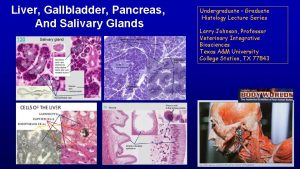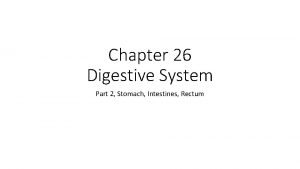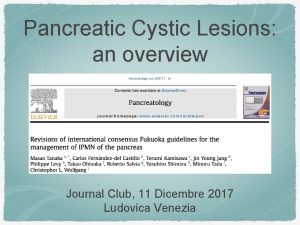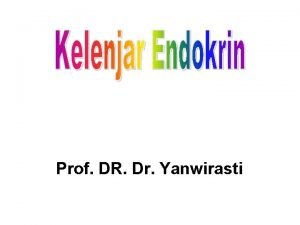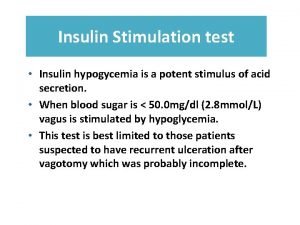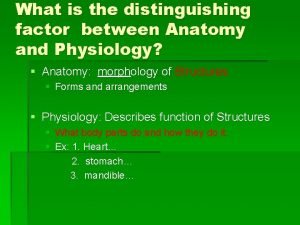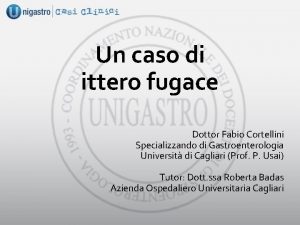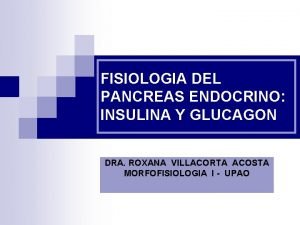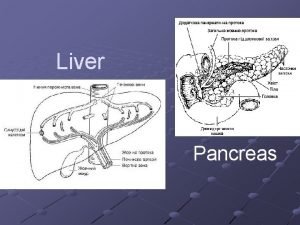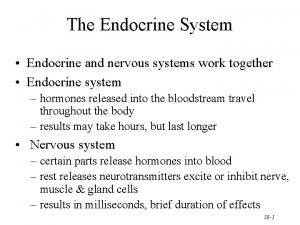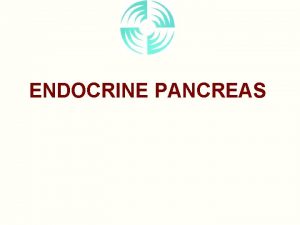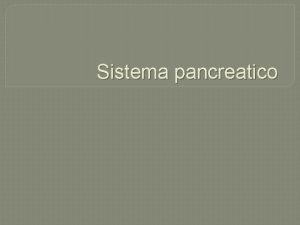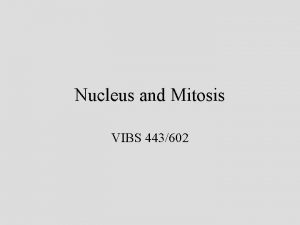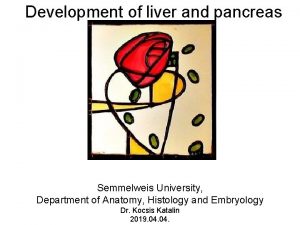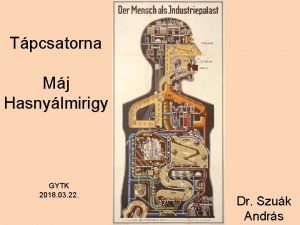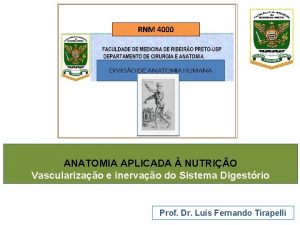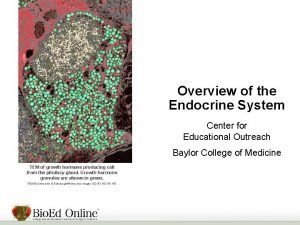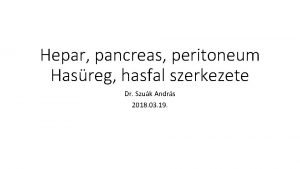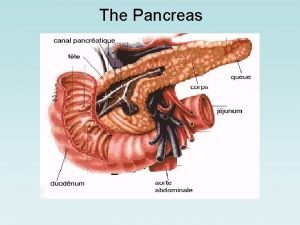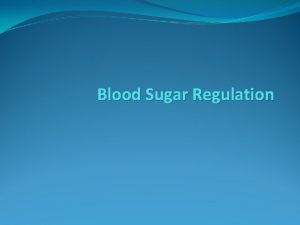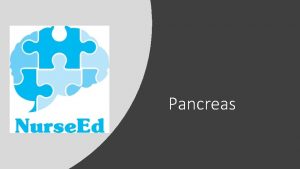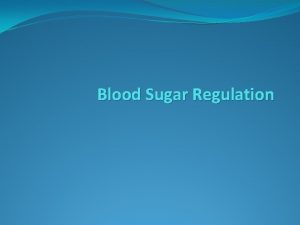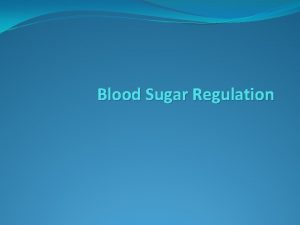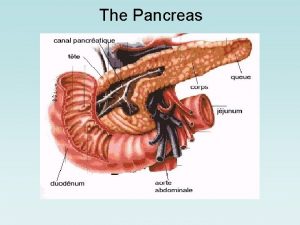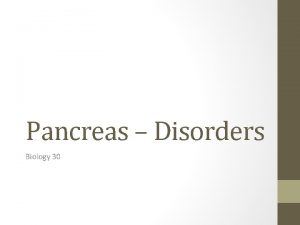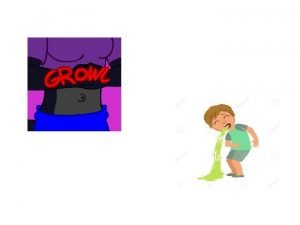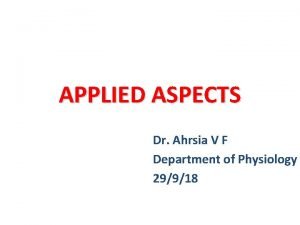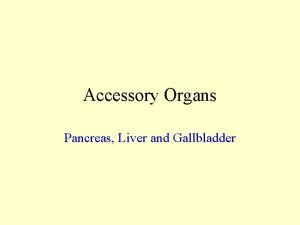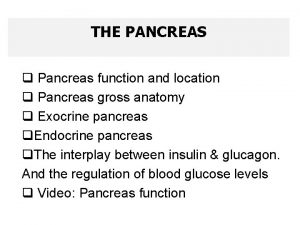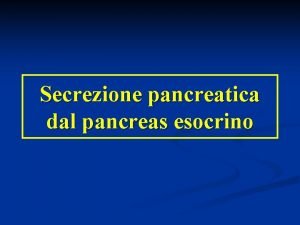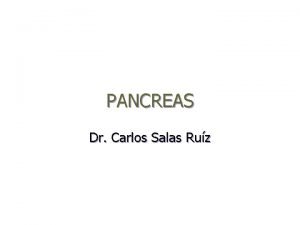Pancreas Dr Ahrsia V F Department of Physiology





















- Slides: 21

Pancreas Dr. Ahrsia V F Department of Physiology 2/2/19

Objectives • Functional anatomy of pancreas. • Pancreatic juice - Composition - Secretion - Regulation • Applied aspects

Functional anatomy of Pancreas


Pancreatic Juice • Volume : 500 to 800 m. L/day • Reaction : Highly alkaline with a p. H of 8 to 8. 3 • Specific gravity : 1. 010 to 1. 018

PROTEOLYTIC ENZYMES: 1. Trypsin: • Trypsinogen • Enterokinase, secreted by duodenal mucosa. • Autocatalytic action Trypsinogen Enterokinase Trypsinogen Trypsin Functions: • Protein Trypsin proteoses and polypeptides. • Activates other pancreatic enzymes.

2. Chymotrypsin : • Chymotrypsinogen • Activated by trypsin Chymotrypsinogen Trypsin Chymotrypsin. Function: • Hydrolyses proteins into small polypeptides

3. Carboxypeptidase A and B • Procarboxipeptidase A and B • Activated by enterokinase and trypsin. Function: • Carboxypeptidase A cleaves carboxy terminal amino acid with aromatic side chain • Carboxypeptidase B cleaves carboxy terminal amino acid with basic side chain. • Polypeptides to amino acids.

4. Elastase: • Proelastase • Activated by trypsin • Digests elastin. 5. Nucleases (ribonuclease and deoxyribonuclease) • Splits nucleic acid of RNA and DNA into nucleotides. 6. Collagenase: • Digests collagen

PANCREATIC LIPASES 1. Pancreatic lipase • Presence of bile salts and colipase enhances it activity. Lipids Pancreatic lipase glycerol + fatty acids. 2. Cholesterol ester hydrolase Cholesterol+ fatty acids. 3. Phospholipase A 2 • It converts Lecithin to Lysolecithin and Cephalin to Lysocephalin

4. Phospholipase B • It converts lysolecithin and lysocephalin to phosphoryl choline and free fatty acids. 5. Bile salt activated lipase • Weak lipolytic action

AMYLOLYTIC ENZYMES Pancreatic amylase: • Digests carbohydrates to form disaccharides Starch Pancreatic lipase Dextrin + maltose

Pancreatic juice secretion • Secretion of pancreatic enzyme: • Formation of aqueous part: Secretion of bicarbonate rich fluid by ductal epithelial cells.


Regulation of pancreatic juice secretion • Cephalic phase • Gastric phase • Intestinal phase



Applied aspects

Pancreatitis Inflammation 1. Acute pancreatitis 2. Chronic pancreatitis. Acute Pancreatitis • Heavy alcohol intake or gallstones. Features of acute pancreatitis: i. Severe upper abdominal pain ii. Nausea and vomiting iii. Loss of appetite and weight iv. Fever and Shock.

Chronic Pancreatitis • Repeated acute inflammation or chronic damage to pancreas. Causes : i. Longtime consumption of alcohol ii. Chronic obstruction of ampulla of Vater by gallstone iii. Hereditary iv. Congenital abnormalities of pancreatic duct v. Idiopathic pancreatitis Features: • Severe pain in upper abdominal region, which radiates to the back • Complete destruction of pancreas • Absence of pancreatic enzymes • Steatorrhea • Fever, nausea and vomiting • Tender and swollen abdomen • Weight loss.

Thank you
 Anatomy and physiology of diabetes
Anatomy and physiology of diabetes Pancreas anatomy histology
Pancreas anatomy histology Pancreas
Pancreas Gastric folds in stomach
Gastric folds in stomach Exocrine tumors of pancreas
Exocrine tumors of pancreas Kelenjar rotter
Kelenjar rotter Ams pancreas
Ams pancreas Pancreas
Pancreas Ampullomi
Ampullomi ¿qué es la homeostasis y ejemplos
¿qué es la homeostasis y ejemplos Liver and pancreas function
Liver and pancreas function Vasopressin function
Vasopressin function Location
Location Prueba de lundh
Prueba de lundh Pancreas anatomy
Pancreas anatomy Criterios ranson pancreatitis aguda
Criterios ranson pancreatitis aguda Histology
Histology Proc uncinatus pancreas
Proc uncinatus pancreas Lig coronarium
Lig coronarium Esôfago
Esôfago Baylor
Baylor Pancreas ductus
Pancreas ductus


